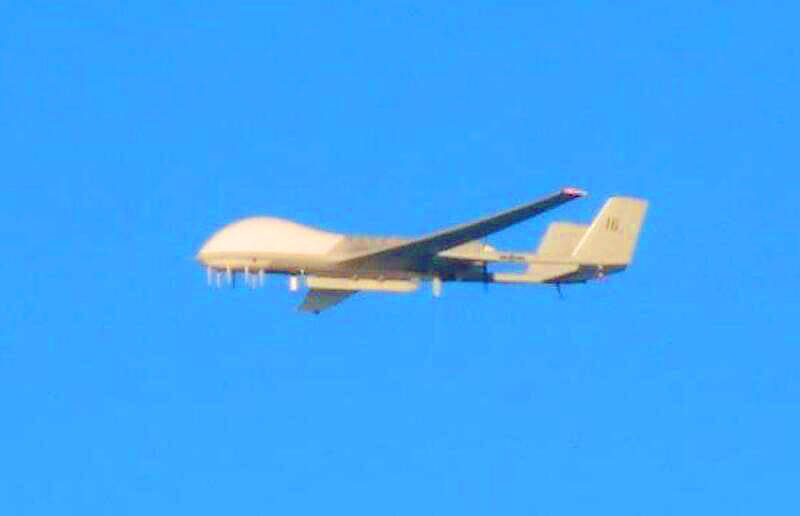China appears to be using a new type of BZK-005 drone that might be capable of disrupting the radio communications in the Taiwanese military and causing the radar system to malfunction, a military source said yesterday.
The military is closely monitoring traces of this upgraded drone after the Japanese Ministry of Defense recently captured images of a BZK-005 drone, which had a large number of antennas under the nose of the aircraft and a pod of unknown purpose attached under the belly of the craft.
Defense experts in other countries had warned that the Chinese People’s Liberation Army (PLA) has bolstered its electronic warfare capability by installing antennaes and pods on some of the drones, a military source told the Liberty Times (sister paper of the Taipei Times), adding that they could be deployed to disrupt all radio communications within the chain of command in the Taiwanese military and cause the radar system to malfunction.

Photo: Screen grab from Japan’s Ministry of Defense Web site
Drones equipped with electronic warfare capabilities would also make it difficult for the Taiwanese military to accurately launch missile attacks and intercept Chinese missiles and aircraft.
The PLA would attempt to use such interference in the initial stage of a possible invasion in Taiwan and during an attack of on the country, they said.
The US military also warned that the PLA might use a swarm of small drones equipped with microwave reconnaissance jamming or electromagnetic weapons to fly into Taiwanese airspace and conduct various jamming operations, they added.
The new BZK-005 reconnaissance drone was spotted on Friday last week, when it flew to the west Pacific via the airspace between Okinawa Island and Miyako Island and flew back using the same route, based on the information made public by the Japanese Ministry of Defense.
The PLA uses BZK-005 and TB-001 drones to fly to Taiwan’s air defense identification zone, as both have reconnaissance and attack capabilities. The former is a large and multifunctional drone, with a maximum endurance time of up to 40 hours. Its cruising altitude could reach 3,000m to 7,000m.
In other news, Minister of Economic Affairs J.W. Kuo (郭智輝) yesterday said in an opening ceremony of the Asia Drone AI Innovation and Application Expo in Chiayi County that some drone manufacturers from the US are to come to Taiwan next month to seek business opportunities.
“I have talked with National Development Council Minister Paul Liu (劉鏡清) about the issues with the drone industry, who said that the National Development Fund should be used to support the industry, as it is important to the country,” Kuo said.
“Although there are not enough drone manufacturers in Taiwan, we are looking to expand the scale of the industry with the US,” he said.
“We also hope that the industry could generate an output value of NT$30 billion [US$925 million] by 2028,” he added.

The Ministry of Foreign Affairs (MOFA) yesterday said it is closely monitoring developments in Venezuela, and would continue to cooperate with democratic allies and work together for regional and global security, stability, and prosperity. The remarks came after the US on Saturday launched a series of airstrikes in Venezuela and kidnapped Venezuelan President Nicolas Maduro, who was later flown to New York along with his wife. The pair face US charges related to drug trafficking and alleged cooperation with gangs designated as terrorist organizations. Maduro has denied the allegations. The ministry said that it is closely monitoring the political and economic situation

Conflict with Taiwan could leave China with “massive economic disruption, catastrophic military losses, significant social unrest, and devastating sanctions,” a US think tank said in a report released on Monday. The German Marshall Fund released a report titled If China Attacks Taiwan: The Consequences for China of “Minor Conflict” and “Major War” Scenarios. The report details the “massive” economic, military, social and international costs to China in the event of a minor conflict or major war with Taiwan, estimating that the Chinese People’s Liberation Army (PLA) could sustain losses of more than half of its active-duty ground forces, including 100,000 troops. Understanding Chinese

UNRELENTING: China attempted cyberattacks on Taiwan’s critical infrastructure 2.63 million times per day last year, up from 1.23 million in 2023, the NSB said China’s cyberarmy has long engaged in cyberattacks against Taiwan’s critical infrastructure, employing diverse and evolving tactics, the National Security Bureau (NSB) said yesterday, adding that cyberattacks on critical energy infrastructure last year increased 10-fold compared with the previous year. The NSB yesterday released a report titled Analysis on China’s Cyber Threats to Taiwan’s Critical Infrastructure in 2025, outlining the number of cyberattacks, major tactics and hacker groups. Taiwan’s national intelligence community identified a large number of cybersecurity incidents last year, the bureau said in a statement. China’s cyberarmy last year launched an average of 2.63 million intrusion attempts per day targeting Taiwan’s critical

‘SLICING METHOD’: In the event of a blockade, the China Coast Guard would intercept Taiwanese ships while its navy would seek to deter foreign intervention China’s military drills around Taiwan this week signaled potential strategies to cut the nation off from energy supplies and foreign military assistance, a US think tank report said. The Chinese People’s Liberation Army (PLA) conducted what it called “Justice Mission 2025” exercises from Monday to Tuesday in five maritime zones and airspace around Taiwan, calling them a warning to “Taiwanese independence” forces. In a report released on Wednesday, the Institute for the Study of War said the exercises effectively simulated blocking shipping routes to major port cities, including Kaohsiung, Keelung and Hualien. Taiwan would be highly vulnerable under such a blockade, because it